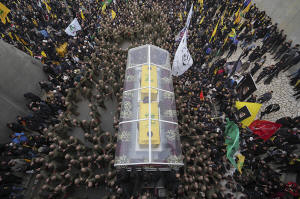Masses of mourners attend the funeral of Hezbollah leader Nasrallah, 5
months after his killing
 Send a link to a friend
Send a link to a friend
 [February 24, 2025]
By BASSEM MROUE, ABBY SEWELL and SALLY ABOU ALJOUD [February 24, 2025]
By BASSEM MROUE, ABBY SEWELL and SALLY ABOU ALJOUD
BEIRUT (AP) — Hundreds of thousands of people packed into a stadium in
Beirut and nearby streets on Sunday for the funeral of Hezbollah's
former leader, Hassan Nasrallah, nearly five months after he was killed
in an Israeli airstrike.
Nasrallah died after Israel’s air force dropped more than 80 bombs on
the militant group’s main operations room in a southern suburb of the
Lebanese capital, dealing a major blow to the Iran-backed group and
political party that he had transformed into a potent force in the
Middle East.
He was one of Hezbollah's founders and led it for more than 30 years,
enjoying wide influence among the so-called Iran-led “axis of
resistance” that also included Iraqi, Yemeni and Palestinian factions.
Nasrallah also became an icon in other parts of the Arab world after
Hezbollah fought Israel to a draw in a brutal monthlong war in 2006, but
the group's image suffered after it intervened on the side of former
President Bashar Assad in Syria's civil war.
Hezbollah called on its supporters to attend the funeral in large
numbers in what appears to be a move to show that it remains powerful
even after suffering significant setbacks in a 14-month war with Israel
that left many of its senior political and military officials dead.
A Lebanese official, who spoke on condition of anonymity because he was
not authorized to speak to the media, estimated the crowd size at
450,000. Others gave higher estimates. The pro-Hezbollah pan-Arab TV
channel Al-Mayadeen reported a figure of 1.4 million.

“This massive crowd confirms that Hezbollah is still the most popular
party at the Lebanese level, and as a result, all the talk that
Hezbollah is weak or degraded is out of place,” said Ali Fayyad, a
lawmaker with the group's political wing, who attended the funeral.
Sahar al-Attar, a mourner who traveled from Lebanon’s Bekaa Valley for
the funeral said, “We would have come even under bullets” to attend
Nasrallah’s burial.
Nasrallah shared the funeral with his cousin and successor, Hashem
Safieddine, who was killed in an Israeli airstrike on a Beirut suburb a
few days later. Nasrallah was laid to rest Sunday in Beirut after the
funeral procession, while Safieddine will be buried in his hometown in
southern Lebanon. Both had temporarily been buried in secret locations.
As the coffins were paraded before the huge crowd, men riding on the
platforms with them tossed flowers. Some in the crowd threw clothing
articles in the hope they would come in contact with the coffins,
believing it would bless them.
Outside of the stadium, giant screens were placed along the road leading
to the airport, titling the funeral: “We are committed to the covenant.”
Hezbollah allies from around the world attend the funeral
Senior Hezbollah official Ali Daamoush told reporters Saturday that
about 800 prominent figures from 65 countries would attend the funeral
in addition to thousands of individuals and activists from around the
world.
[to top of second column]
|

A trailer carrying the coffins containing the bodies of Hezbollah's
former leader Hassan Nasrallah and his cousin and successor Hashem
Safieddine drives through the crowd during a funeral procession at
the Sports City Stadium in Beirut, Lebanon, Sunday, Feb. 23, 2025.
(AP Photo/Hassan Ammar)

Iranian parliament Speaker Mohammad Bagher Qalibaf and Foreign
Minister Abbas Araghchi were among the officials who arrived at the
Lebanese capital’s main sports stadium. Lebanon's parliament speaker
and representatives of the president and prime minister were also in
attendance.
The funeral also drew non-official participants from outside of
Lebanon, including some from Western countries.
Irish activist Tara O’Grady waved the flag of her country and said
that she came to Beirut “to stand with the people of Lebanon and
their resistance against the Zionist regime who are brutally
continuing to bomb the south of Lebanon.” She likened Nasrallah to
Irish early-20th century revolutionary Michael Collins.
As O’Grady spoke with The Associated Press, four Israeli warplanes
flew at low altitude over Beirut while Nasrallah’s coffin was
paraded into the stadium. The crowd chanted: “Death to Israel” and
“At your service, Nasrallah.”
Israeli Defense Minister Israel Katz said in a statement that the
fighter jets flying over the funeral “send a clear message: Whoever
threatens to annihilate Israel and strike Israel — that will be his
end.”
Hours before and during the funeral, the Israeli military also
launched a series of strikes in southern and eastern Lebanon. Also
on Sunday, the Israeli military released a video that said it shows
the airstrike that killed Nasrallah and some of the group’s top
military officials on Sept. 27, 2024.
Hezbollah remains defiant
As part of the U.S.-brokered ceasefire that ended the war with
Israel on Nov. 27, Hezbollah is not supposed to have an armed
presence along the border with Israel.
The group was dealt another blow with the fall of the Assad family’s
five-decade rule in Syria in early December, which blocked a main
route for the flow of weapons and money from Iran. Its rivals have
been calling on it to lay down its weapons all over Lebanon and
become a political faction.
Nasrallah's successor, Hezbollah’s current Secretary-General Naim
Kassem, said in a televised speech played at the funeral that “the
resistance is still present and strong in numbers and weapons, and
the inevitable victory is coming." He was not at the stadium.
Kassem added that “Israel must withdraw from the areas it still
occupies" in southern Lebanon, referring to five strategic border
points where Israeli forces remain.
All contents © copyright 2025 Associated Press. All rights reserved
 |